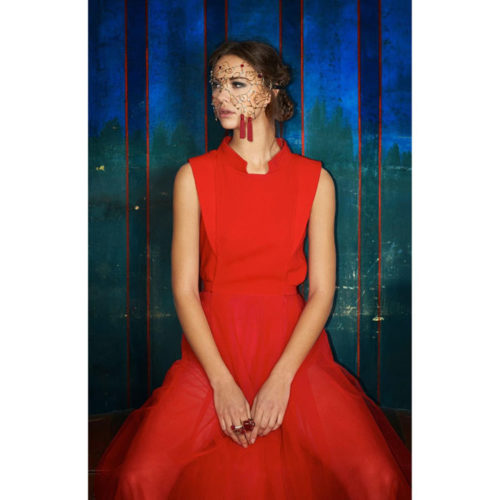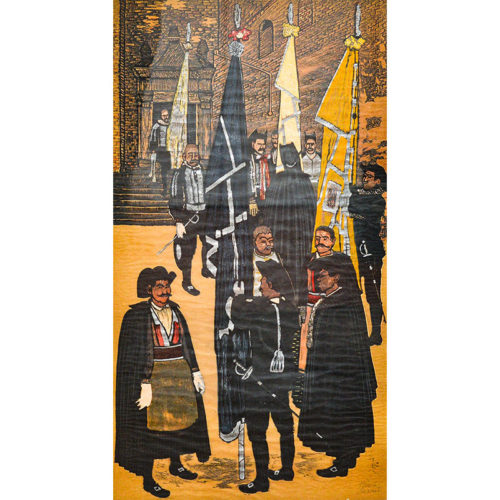-
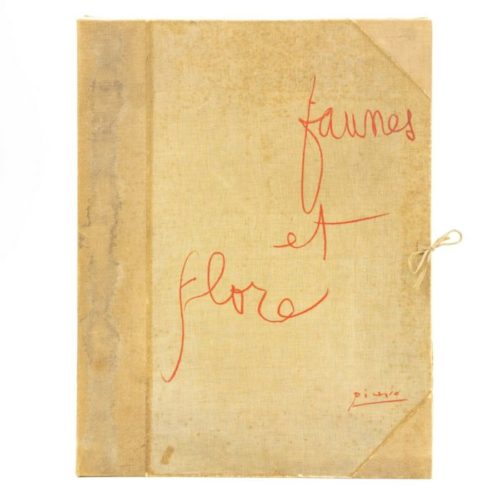 "Faunes et Flore d'Antibes" - Edition 46/175 - "Au Pont des Arts". Original album from 1960, containing 7 colour lithographs. Printed by Daniel Jacomet under the supervision of Picasso, Paris. Introduction by Jaime Sabartes, New York Graphic Society - Au Pont Des Arts, Paris, 1960. The Portfolio reproduces 7 paintings on paper by Pablo Picasso, from the series: "La joie de vivre", Antibes August/September 1946, plus the frontispiece that was specially designed by Picasso for this edition. Printed on paper marked Arches and preserved in the original linen folder. The prints are reproduced in the original format of the paintings, and the dimensions of the folder are: H 65 x W 50 cm. The linen folder and the prints are in very good condition. One hundred and seventy-five numbered copies, this being 46 of 175. Period: 1960 Measurements: H 65 x W 50 cm
"Faunes et Flore d'Antibes" - Edition 46/175 - "Au Pont des Arts". Original album from 1960, containing 7 colour lithographs. Printed by Daniel Jacomet under the supervision of Picasso, Paris. Introduction by Jaime Sabartes, New York Graphic Society - Au Pont Des Arts, Paris, 1960. The Portfolio reproduces 7 paintings on paper by Pablo Picasso, from the series: "La joie de vivre", Antibes August/September 1946, plus the frontispiece that was specially designed by Picasso for this edition. Printed on paper marked Arches and preserved in the original linen folder. The prints are reproduced in the original format of the paintings, and the dimensions of the folder are: H 65 x W 50 cm. The linen folder and the prints are in very good condition. One hundred and seventy-five numbered copies, this being 46 of 175. Period: 1960 Measurements: H 65 x W 50 cm -
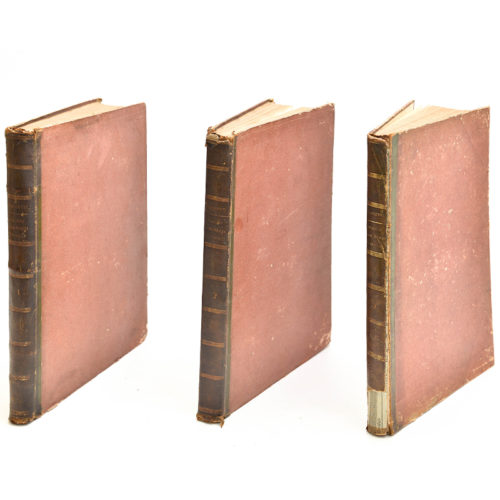 Three volumes entitled "Romantic pictorial journey of the western provinces of ancient and modern Italy" by the lawyer Modesto Paroletti, a work adorned with lithographic perspective views drawn from life. Turin Felice Festa printing factory.Period: Early 19th century Measurements: L 31.5 x H 46 cm
Three volumes entitled "Romantic pictorial journey of the western provinces of ancient and modern Italy" by the lawyer Modesto Paroletti, a work adorned with lithographic perspective views drawn from life. Turin Felice Festa printing factory.Period: Early 19th century Measurements: L 31.5 x H 46 cm -
Out of stock
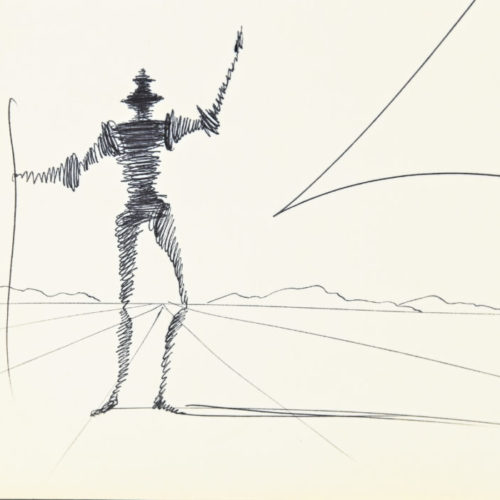 "Dali - De Draeger" catalogue by Max Gérard, 1968. The catalogue has a drawing of Don Quixote, with a dedication on the guard paper, a gift from the Catalan artist Salvador Dali (Figueras 1904 - 1989) "Every morning, as I wake up, I experience a supreme pleasure that I am discovering today for the first time: that of being Salvador Dali, and I wonder, filled with wonder, what this Salvador Dali will do again today that is so prodigious. And every day it is more difficult for me to understand how others can live without being Gala or Salvador Dali. A Catalan with a thirst for gold and glory, Dali painted a lot and talked a lot. His favourite subject: how to become a genius. His conclusion: 'Oh, Salvador, now you know, if you play at being a genius, you will become one! Salvador Dali's taste for provocation, excessive character, pursuit of paradox and exaggerated egocentricity have made him a well-known figure to the general public. These elements have helped to turn a great artist - endowed with a fervid creative intelligence and a profound knowledge of the history of the arts, the masters of the past and the literary research of his time - into a myth, which still arouses great curiosity today. However, his continuous exposure as an absolute 'genius' of art, to critics and to the judgement of the public, has given the impression of being able to fully understand his work and easily enter into his thought. In reality, his entire oeuvre reveals a very complex personality. Like his compatriot Picasso, Dali experimented with different expressive languages during his long career, moving away from painting towards cinema, theatre, photography and even performance. "At the age of six I wanted to be a cook. At seven I wanted to be Napoleon. And my ambition has been steadily growing ever since". Dali's life and work are inextricably intertwined, in fact many events in the artist's life were reflected in his creations, and many paintings can only be understood on the basis of the events that marked his life. At the age of six he painted his first canvas. Then, at the age of ten, he received his first drawing lesson, under the guidance of the famous Impressionist painter Ramón Pichot (1872 - 1925). He would later say that he was influenced by Pichot's works, which represented his first contact with a non-academic artistic current, focused on the reality of his time. At the age of fourteen he discovered the pompiers, at twenty-two cubism and at twenty-four he was already Dali, convinced that he had been called Salvador because he was destined to be the "saviour" of painting threatened with death by abstract art, academic surrealism, Dadaism in general and all the anarchic isms. At the age of 25, he was already winning over critics, doing business with gallery owners and collecting scandals. Period: 1968 Measurements: Page size with drawing and dedication H 30 x W 27.5 cm
"Dali - De Draeger" catalogue by Max Gérard, 1968. The catalogue has a drawing of Don Quixote, with a dedication on the guard paper, a gift from the Catalan artist Salvador Dali (Figueras 1904 - 1989) "Every morning, as I wake up, I experience a supreme pleasure that I am discovering today for the first time: that of being Salvador Dali, and I wonder, filled with wonder, what this Salvador Dali will do again today that is so prodigious. And every day it is more difficult for me to understand how others can live without being Gala or Salvador Dali. A Catalan with a thirst for gold and glory, Dali painted a lot and talked a lot. His favourite subject: how to become a genius. His conclusion: 'Oh, Salvador, now you know, if you play at being a genius, you will become one! Salvador Dali's taste for provocation, excessive character, pursuit of paradox and exaggerated egocentricity have made him a well-known figure to the general public. These elements have helped to turn a great artist - endowed with a fervid creative intelligence and a profound knowledge of the history of the arts, the masters of the past and the literary research of his time - into a myth, which still arouses great curiosity today. However, his continuous exposure as an absolute 'genius' of art, to critics and to the judgement of the public, has given the impression of being able to fully understand his work and easily enter into his thought. In reality, his entire oeuvre reveals a very complex personality. Like his compatriot Picasso, Dali experimented with different expressive languages during his long career, moving away from painting towards cinema, theatre, photography and even performance. "At the age of six I wanted to be a cook. At seven I wanted to be Napoleon. And my ambition has been steadily growing ever since". Dali's life and work are inextricably intertwined, in fact many events in the artist's life were reflected in his creations, and many paintings can only be understood on the basis of the events that marked his life. At the age of six he painted his first canvas. Then, at the age of ten, he received his first drawing lesson, under the guidance of the famous Impressionist painter Ramón Pichot (1872 - 1925). He would later say that he was influenced by Pichot's works, which represented his first contact with a non-academic artistic current, focused on the reality of his time. At the age of fourteen he discovered the pompiers, at twenty-two cubism and at twenty-four he was already Dali, convinced that he had been called Salvador because he was destined to be the "saviour" of painting threatened with death by abstract art, academic surrealism, Dadaism in general and all the anarchic isms. At the age of 25, he was already winning over critics, doing business with gallery owners and collecting scandals. Period: 1968 Measurements: Page size with drawing and dedication H 30 x W 27.5 cm -
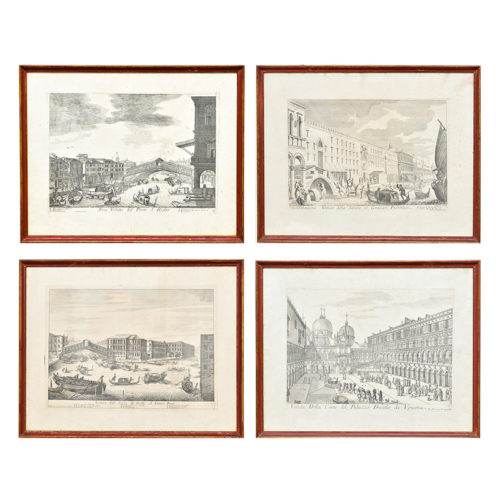 Period: 1717 Measurements: In frame H 53 x L 67 / Paper H 48 x L 61 cm"Venice" - Lithographs by Filippo Vasconi (1687 - 1730) for Domenico Lovisa (1690 - 1750), dating back to 1717. The four lithographs represent:
Period: 1717 Measurements: In frame H 53 x L 67 / Paper H 48 x L 61 cm"Venice" - Lithographs by Filippo Vasconi (1687 - 1730) for Domenico Lovisa (1690 - 1750), dating back to 1717. The four lithographs represent:- "View of the Court of the Doge's Palace in Venice" from The Gran Teatro di Venezia
- "View of the Rialto Island with the Famous Bridge" from The Gran Teatro di Venezia
- "View of Health and Public Granaries" from The Gran Teatro di Venezia
- "Other View of the Rialto Bridge" from The Gran Teatro di Venezia
-
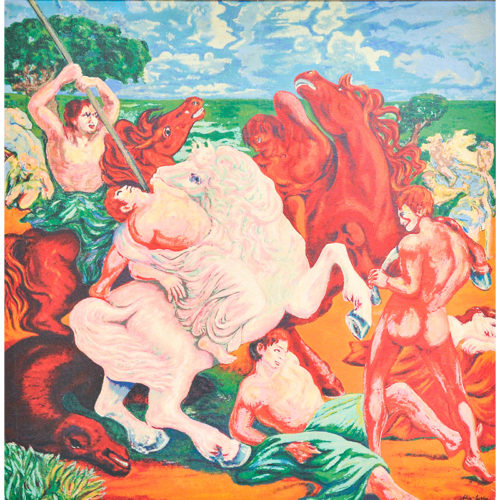 Large original screenprint by Aligi Sassu (1912-2000). SASSU ALIGI. Born on July 17, 1912 in Milan. For his father's Sardinian origins, he spent several years of his childhood in Thiesi (Sassari). His first essays are from 1926. He participated in the futurist movement until 1930; then he broke away. He had contacts in Milan with Edoardo Persico and Raffaele Carrieri; around 1931 he was in opposition to the Italian twentieth century, with Birolli, Manzù, Grosso, Tomea. He exhibited for the first time at the Venetian Biennale in 1928; his first personal is in 1930, at the Galleria del Milione. In 1934 he was in Paris, where he obtained success at the Galerie des Quatre Chemins. Since 1935, after returning to Milan, he has taken part in numerous artistic events. He participated in the first two editions of the Bergamo Prize; at the Sacred Art Exhibition in Bergamo he received the first prize with the work Deposition. He is an etching, lithographer, ceramist; he created works of sculpture, frescoes, stained glass, scenography. In 1957 he created a large cycle of mosaics in the apse of the Chiesa del Carmine in Cagliari; His works have been presented in numerous cities, including abroad: in the U.S.A. in 1933; in London in 1935; in Buenos Aires in 1947; and in Paris, Boston, Lisbon, Bucharest (where an anthology of paintings and graphic works was set up in 1966). Among the major solo shows in Italy, we mention: the one concerning graphics and sculpture carried out in the Galleria Civica di Monza in 1965; that of 1966 in Palermo presented by Salvatore Quasimodo; Period: 20th century Measures: H 163 x L 159 x P 4.5 / Canvas H 151 x L 146 cm
Large original screenprint by Aligi Sassu (1912-2000). SASSU ALIGI. Born on July 17, 1912 in Milan. For his father's Sardinian origins, he spent several years of his childhood in Thiesi (Sassari). His first essays are from 1926. He participated in the futurist movement until 1930; then he broke away. He had contacts in Milan with Edoardo Persico and Raffaele Carrieri; around 1931 he was in opposition to the Italian twentieth century, with Birolli, Manzù, Grosso, Tomea. He exhibited for the first time at the Venetian Biennale in 1928; his first personal is in 1930, at the Galleria del Milione. In 1934 he was in Paris, where he obtained success at the Galerie des Quatre Chemins. Since 1935, after returning to Milan, he has taken part in numerous artistic events. He participated in the first two editions of the Bergamo Prize; at the Sacred Art Exhibition in Bergamo he received the first prize with the work Deposition. He is an etching, lithographer, ceramist; he created works of sculpture, frescoes, stained glass, scenography. In 1957 he created a large cycle of mosaics in the apse of the Chiesa del Carmine in Cagliari; His works have been presented in numerous cities, including abroad: in the U.S.A. in 1933; in London in 1935; in Buenos Aires in 1947; and in Paris, Boston, Lisbon, Bucharest (where an anthology of paintings and graphic works was set up in 1966). Among the major solo shows in Italy, we mention: the one concerning graphics and sculpture carried out in the Galleria Civica di Monza in 1965; that of 1966 in Palermo presented by Salvatore Quasimodo; Period: 20th century Measures: H 163 x L 159 x P 4.5 / Canvas H 151 x L 146 cm -
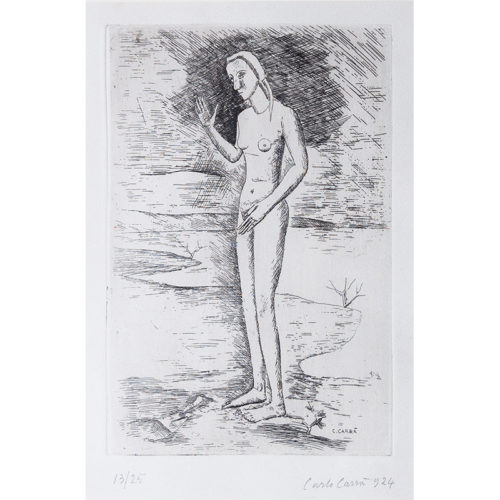 The birth of Venus, work of 1923, signed and dated 1924 in the lower right and numbered in the lower left 13/25 by the author Carlo Dalmazio Carrà (Quargnento, 11 February 1881 - Milan, 13 April 1966), Italian painter and teacher , professor at the Brera Academy from 1939 to 1951. This work is part of the "transcendent period" of the painter who since 1922 abandoned metaphysics, driven by the desire to "be only himself". Painting must grasp that relationship which includes the need to identify with things and the need for abstraction "and the contemplation of the landscape is then resolved in the" construction "of a painting, both mountain and marine. He also knows the Milanese painter-poet Cesare Breveglieri (who portrayed him while he was painting).Period: 1924 Measurements: In frame H 53.5 x L 41.5 / Paper H 31 x L 20.6 cm
The birth of Venus, work of 1923, signed and dated 1924 in the lower right and numbered in the lower left 13/25 by the author Carlo Dalmazio Carrà (Quargnento, 11 February 1881 - Milan, 13 April 1966), Italian painter and teacher , professor at the Brera Academy from 1939 to 1951. This work is part of the "transcendent period" of the painter who since 1922 abandoned metaphysics, driven by the desire to "be only himself". Painting must grasp that relationship which includes the need to identify with things and the need for abstraction "and the contemplation of the landscape is then resolved in the" construction "of a painting, both mountain and marine. He also knows the Milanese painter-poet Cesare Breveglieri (who portrayed him while he was painting).Period: 1924 Measurements: In frame H 53.5 x L 41.5 / Paper H 31 x L 20.6 cm -
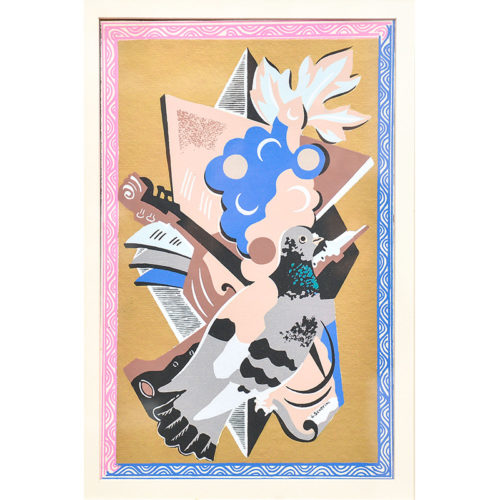 Multiple print on Lafuma paper entitled "Nature Morte au Pigeon" by Gino Severini (Cortona 1883 - Paris 1966) Thirteenth table in the folder "Fleures et Masques" by G. Severini published in London in 1930. "Fleurs et masques" is made up of 16 engraved and colored plates "au pochoirs", it has a unique edition of 125 copies. The author was among the signatories in 1909 of the Manifesto of Futurism written by Filippo Tommaso Marinetti. In Paris he was in contact with Pablo Picasso, Georges Braque, Juan Gris and Guillaume Apollinaire, and participated in the birth and development of Cubism. Technique: PouchoirPeriod: 1930 Measurements: In frame H 56 x L 44 cm / Print H 35 x L 21.5 cm
Multiple print on Lafuma paper entitled "Nature Morte au Pigeon" by Gino Severini (Cortona 1883 - Paris 1966) Thirteenth table in the folder "Fleures et Masques" by G. Severini published in London in 1930. "Fleurs et masques" is made up of 16 engraved and colored plates "au pochoirs", it has a unique edition of 125 copies. The author was among the signatories in 1909 of the Manifesto of Futurism written by Filippo Tommaso Marinetti. In Paris he was in contact with Pablo Picasso, Georges Braque, Juan Gris and Guillaume Apollinaire, and participated in the birth and development of Cubism. Technique: PouchoirPeriod: 1930 Measurements: In frame H 56 x L 44 cm / Print H 35 x L 21.5 cm -
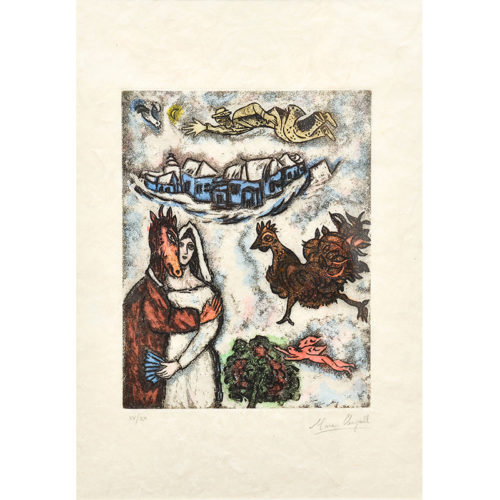 Lithograph on Japanese paper by Marc Chagall (Lëzna, 7 July 1887 - Saint-Paul-de-Vence, 28 March 1985), was a French Russian-born painter of Hasidic Jewish origin. Numbered lithograph (XV / XX) on the bottom left, with the signature on the bottom right.Period: 70s Measurements: In frame H 72.5 x L 53 cm / Sheet H 49 x L 34.5 cm
Lithograph on Japanese paper by Marc Chagall (Lëzna, 7 July 1887 - Saint-Paul-de-Vence, 28 March 1985), was a French Russian-born painter of Hasidic Jewish origin. Numbered lithograph (XV / XX) on the bottom left, with the signature on the bottom right.Period: 70s Measurements: In frame H 72.5 x L 53 cm / Sheet H 49 x L 34.5 cm
